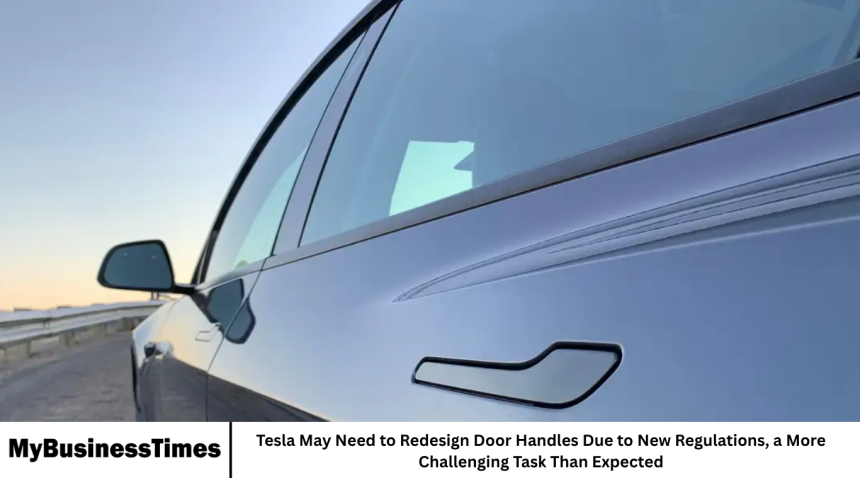Tesla is facing new regulatory requirements that could force the company to redesign its iconic door handles. While these handles have been praised for their sleek, futuristic design, complying with updated safety and accessibility regulations presents a significant engineering challenge. The situation highlights how even small design elements in vehicles can become complex regulatory hurdles.
- Why Tesla’s Door Handles Are Unique
- The Regulatory Challenge
- Technical Difficulties of Redesign
- Impact on Production and Customers
- Industry Implications
- Conclusion
- Frequently Asked Questions
- Why does Tesla need to redesign its door handles?
- How are Tesla’s door handles different from traditional handles?
- Will the redesign affect current Tesla models?
- What technical challenges are involved in the redesign?
- Could this delay Tesla vehicle deliveries?
- How might the redesign impact customers?
- Are other automakers facing similar regulatory challenges?
- Does this affect the cost of Tesla vehicles?
- How long might it take to implement the redesign?
- Why is this important for automotive innovation?
Why Tesla’s Door Handles Are Unique
Tesla’s door handles are known for their flush, retractable design that pops out when touched. This not only gives the vehicle a smooth, aerodynamic look but also contributes to the brand’s futuristic appeal. Unlike traditional door handles, Tesla’s design relies on electronic mechanisms and precise sensor alignment, making any changes far from simple.
The Regulatory Challenge
New regulations may require door handles to meet stricter safety, accessibility, and mechanical standards. This could include easier access for emergency responders, improved durability, or better ergonomics for all users. Implementing these changes is more complicated than it might seem, as it requires maintaining the balance between aesthetic appeal, usability, and technical feasibility.
Technical Difficulties of Redesign
Redesigning Tesla’s door handles involves reengineering mechanical parts, sensors, and software that control the automatic extension and retraction. Any modification must ensure reliability, comply with safety standards, and preserve the vehicle’s signature design. Engineers must also consider production scalability, cost, and integration with existing models, which adds layers of complexity.
Impact on Production and Customers
If Tesla is forced to implement a redesign, it could affect production timelines and vehicle deliveries. Existing models may need retrofitting, and future cars could see delays as engineers test and validate the new door handle system. Customers may experience changes in design or functionality, which could influence the brand perception of Tesla’s innovative approach.
Industry Implications
Tesla is not the only company affected by evolving automotive regulations. The challenge of redesigning a seemingly minor component illustrates how regulations can influence design choices across the industry. Automakers must constantly adapt to meet safety and accessibility standards while maintaining brand identity and consumer expectations.
Conclusion
Tesla’s door handles are more than a design feature; they represent a combination of aesthetics, engineering, and innovation. New regulations could require significant changes, making what seems like a small adjustment a complex engineering project. The situation emphasizes how regulatory compliance and innovation must coexist in modern automotive design.
Frequently Asked Questions
Why does Tesla need to redesign its door handles?
New regulations may require improvements in safety, accessibility, or durability that Tesla’s current handles do not fully meet.
How are Tesla’s door handles different from traditional handles?
They are flush and electronically retractable, offering a sleek look and improved aerodynamics compared to conventional handles.
Will the redesign affect current Tesla models?
It could potentially lead to retrofitting or adjustments in production for new vehicles to comply with regulations.
What technical challenges are involved in the redesign?
Engineers must adjust mechanical parts, sensors, and software while preserving reliability, aesthetics, and usability.
Could this delay Tesla vehicle deliveries?
Yes, production timelines may be affected while new door handle designs are tested and validated.
How might the redesign impact customers?
Customers could see changes in functionality or design, which may influence their experience with Tesla vehicles.
Are other automakers facing similar regulatory challenges?
Yes, evolving safety and accessibility standards affect automakers worldwide, requiring adjustments in design and engineering.
Does this affect the cost of Tesla vehicles?
Potentially, as redesigns can increase production costs and require investment in new parts and testing.
How long might it take to implement the redesign?
The timeline depends on engineering, testing, production adjustments, and regulatory approval.
Why is this important for automotive innovation?
It highlights the balance between maintaining innovative designs and complying with regulatory standards that ensure safety and accessibility.









